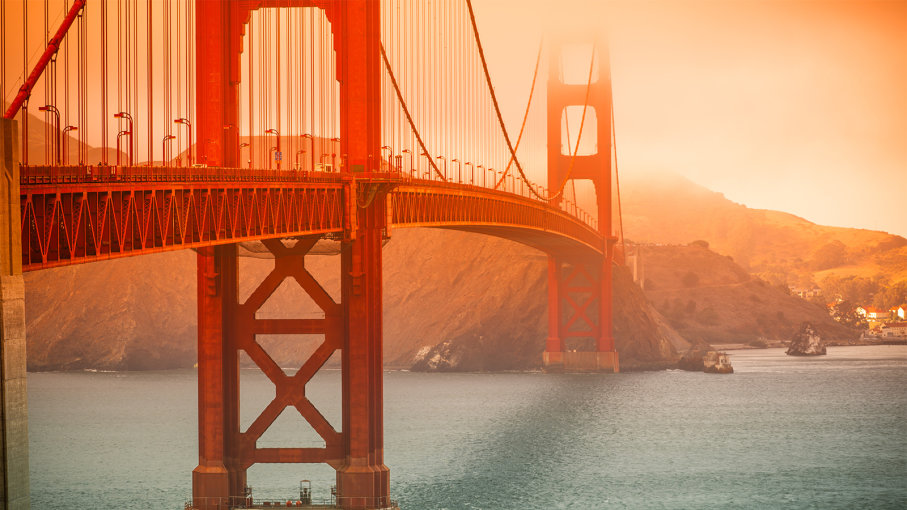How San Francisco’s Golden Gate Bridge Was Built, and Why It’s Not Actually Red

When it came to laying out the design for my second tattoo, I knew two things: 1) I wanted a simple line drawing that ran from my right elbow to my wrist, and 2) I needed to have the Golden Gate Bridge integrated in some way. As San Francisco has drastically transformed over the last few decades, I’ve taken (arguably too much) pride in being one of the few true natives, born and raised in an area of the city adjacent to the bridge’s Presidio entrance. And while I’m comfortable letting the visual representation of the iconic landmark on my arm speak for itself, digging into the history and significance of the bridge offers some pretty cool insight into my hometown’s unique charm.
The Original Idea
It all started in 1916. Or actually, it started around four decades earlier, in 1872, when railroad entrepreneur Charles Crocker called for a bridge to span the Golden Gate Strait, the 3-mile (5-kilometer) long stretch of water that connects the San Francisco Bay to the Pacific Ocean. But it wasn’t until the early 20th century that the project gained traction as the area’s population grew and traffic congestion at the ferry docks was becoming a serious issue. James H. Wilkins, a structural engineer and newspaper editor for the San Francisco Call Bulletin, connected with San Francisco City engineer Michael M. O’Shaughnessy and started talking about what it would really take to make a bridge connecting the city to the Marin Headlands a reality.
Three years later, San Francisco officials formally requested that O’Shaughnessy explore the possibility of building a strait-spanning bridge and the engineer began consulting with colleagues around the country. Sure, the idea of connecting San Francisco to the North Bay was nice, but was it financially feasible? Most industry insiders speculated that such an undertaking would cost over $100 million and that — perhaps more importantly — it just couldn’t be built. Joseph Baermann Strauss, however, begged to differ.
Strauss, a Chicago-based engineer, presented a plan that not only made a bridge seem possible, but downright affordable: Strauss’s plan estimated that the construction could be done for $25 to $30 million. Strauss submitted his preliminary sketches to O’Shaughnessy and Edward Rainey, secretary to James Rolph, the mayor of San Francisco, on June 28, 1921. While his original design (a $17 million symmetrical cantilever-suspension hybrid span) needed some tweaking and didn’t pan out, O’Shaughnessy made the design public in December 1922, and although the press described it as “ugly,” there was surprisingly little public opposition to the ambitious endeavor.
The Construction Process
While citizens seemed relatively open to approving the massive undertaking, there were more than a few snags along the way to construction. First, O’Shaughnessy and Strauss had to assemble a special district of the state of California to oversee the financing, design and construction of the bridge as a way to give all counties a voice in the process. But ultimately, the fate of the bridge was in the hands of the War Department, which legally ruled all harbor construction potentially affecting shipping traffic or military logistics. When the War Department held a hearing May 16, 1924, to discuss the bridge’s potential impact on navigation and financial burden, things got thorny. Plenty of people voiced their opposition, especially the local ferry companies who started a serious anti-bridge campaign in an effort to halt construction. And they succeeded — for eight years.
Golden Gate Bridge
Construction begins on the Golden Gate Bridge in 1933.
LIBRARY OF CONGRESS
But after nearly a decade of jurisdiction and uncertainty, Strauss and O’Shaughnessy were able to create the Golden Gate Bridge and Highway District (composed of the area’s six member counties), incorporated by the California state legislature in 1928 as the sole entity responsible for the final design, construction and financing of the future bridge.
Secretary of War Patrick Hurley issued the construction permit Aug. 11, 1930 and the building process officially kicked off nearly three years later on Jan. 5, 1933. By this time, the vast majority of residents were stoked, and a groundbreaking ceremony at nearby Crissy Field helped hype the locals for what was to be a somewhat lengthy, but easier-than-expected process.
“An interesting fact about the Golden Gate Bridge is that it was completed ahead of schedule and under budget — a rarity in today’s construction world,” Paolo Cosulich-Schwartz, public affairs manager for the Golden Gate Bridge, Highway & Transportation District, writes via email. “The bridge was completed in May 1937 under budget and six months ahead of schedule. It cost about $39 million to build, which equals about $500 million in today’s dollars.”
Not only did the bridge make a name for itself as a relatively quick and painless project (as far as massive constructions go), it also made a mark on history with its construction procedures and safety measures.
“The Golden Gate Bridge was a pioneering project for protecting workers by requiring bridge builders to wear hard hats and installing the first safety net for bridge workers,” Cosulich-Schwartz says. “I’m proud that the legacy of safety lives on at the Golden Gate Bridge today.” Although 11 men died during construction (not unheard of in that risky era of building), a safety net suspended under the “floor” of the bridge during construction saved the lives of 19 men who became known as the “Halfway-to-Hell Club.”



 Creators of mankind
Creators of mankind Description of “Tall white aliens”
Description of “Tall white aliens” Where they came from?
Where they came from? About hostile civilizations
About hostile civilizations The war for the Earth
The war for the Earth “Tall white aliens” about eternal life
“Tall white aliens” about eternal life Video: “Nordic aliens”
Video: “Nordic aliens” Aliens
Aliens Alien encounters
Alien encounters The aliens base
The aliens base UFO
UFO Technology UFO
Technology UFO Underground civilization
Underground civilization Ancient alien artifacts
Ancient alien artifacts Military and UFO
Military and UFO Mysteries and hypotheses
Mysteries and hypotheses Scientific facts
Scientific facts


















